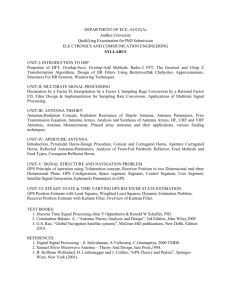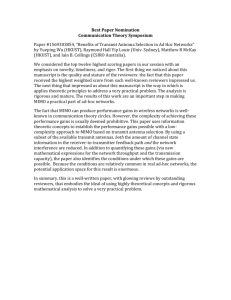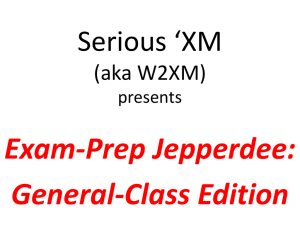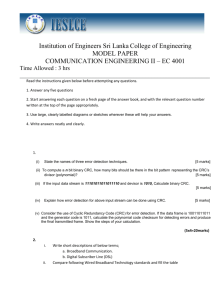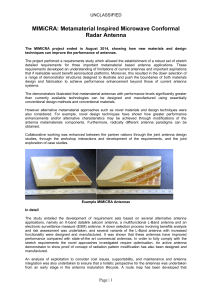2. H-shaped Antennas
advertisement
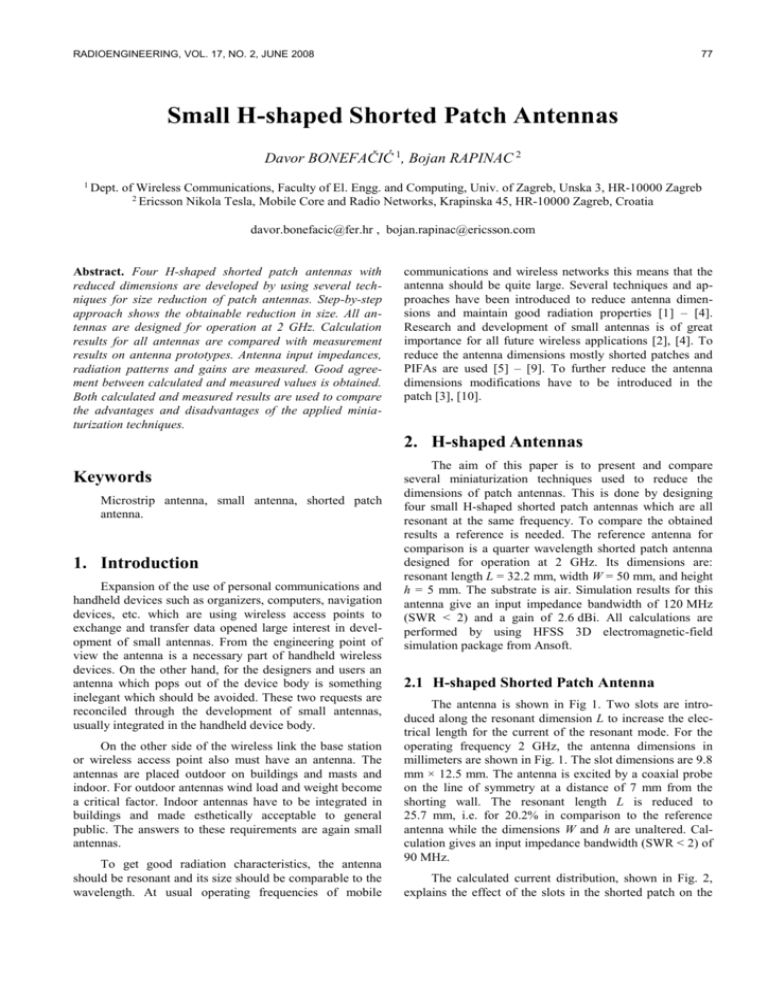
RADIOENGINEERING, VOL. 17, NO. 2, JUNE 2008 77 Small H-shaped Shorted Patch Antennas Davor BONEFAČIĆ 1, Bojan RAPINAC 2 1 Dept. of Wireless Communications, Faculty of El. Engg. and Computing, Univ. of Zagreb, Unska 3, HR-10000 Zagreb 2 Ericsson Nikola Tesla, Mobile Core and Radio Networks, Krapinska 45, HR-10000 Zagreb, Croatia davor.bonefacic@fer.hr , bojan.rapinac@ericsson.com Abstract. Four H-shaped shorted patch antennas with reduced dimensions are developed by using several techniques for size reduction of patch antennas. Step-by-step approach shows the obtainable reduction in size. All antennas are designed for operation at 2 GHz. Calculation results for all antennas are compared with measurement results on antenna prototypes. Antenna input impedances, radiation patterns and gains are measured. Good agreement between calculated and measured values is obtained. Both calculated and measured results are used to compare the advantages and disadvantages of the applied miniaturization techniques. communications and wireless networks this means that the antenna should be quite large. Several techniques and approaches have been introduced to reduce antenna dimensions and maintain good radiation properties [1] – [4]. Research and development of small antennas is of great importance for all future wireless applications [2], [4]. To reduce the antenna dimensions mostly shorted patches and PIFAs are used [5] – [9]. To further reduce the antenna dimensions modifications have to be introduced in the patch [3], [10]. 2. H-shaped Antennas Keywords Microstrip antenna, small antenna, shorted patch antenna. 1. Introduction Expansion of the use of personal communications and handheld devices such as organizers, computers, navigation devices, etc. which are using wireless access points to exchange and transfer data opened large interest in development of small antennas. From the engineering point of view the antenna is a necessary part of handheld wireless devices. On the other hand, for the designers and users an antenna which pops out of the device body is something inelegant which should be avoided. These two requests are reconciled through the development of small antennas, usually integrated in the handheld device body. On the other side of the wireless link the base station or wireless access point also must have an antenna. The antennas are placed outdoor on buildings and masts and indoor. For outdoor antennas wind load and weight become a critical factor. Indoor antennas have to be integrated in buildings and made esthetically acceptable to general public. The answers to these requirements are again small antennas. To get good radiation characteristics, the antenna should be resonant and its size should be comparable to the wavelength. At usual operating frequencies of mobile The aim of this paper is to present and compare several miniaturization techniques used to reduce the dimensions of patch antennas. This is done by designing four small H-shaped shorted patch antennas which are all resonant at the same frequency. To compare the obtained results a reference is needed. The reference antenna for comparison is a quarter wavelength shorted patch antenna designed for operation at 2 GHz. Its dimensions are: resonant length L = 32.2 mm, width W = 50 mm, and height h = 5 mm. The substrate is air. Simulation results for this antenna give an input impedance bandwidth of 120 MHz (SWR < 2) and a gain of 2.6 dBi. All calculations are performed by using HFSS 3D electromagnetic-field simulation package from Ansoft. 2.1 H-shaped Shorted Patch Antenna The antenna is shown in Fig 1. Two slots are introduced along the resonant dimension L to increase the electrical length for the current of the resonant mode. For the operating frequency 2 GHz, the antenna dimensions in millimeters are shown in Fig. 1. The slot dimensions are 9.8 mm × 12.5 mm. The antenna is excited by a coaxial probe on the line of symmetry at a distance of 7 mm from the shorting wall. The resonant length L is reduced to 25.7 mm, i.e. for 20.2% in comparison to the reference antenna while the dimensions W and h are unaltered. Calculation gives an input impedance bandwidth (SWR < 2) of 90 MHz. The calculated current distribution, shown in Fig. 2, explains the effect of the slots in the shorted patch on the D. BONEFAČIĆ, B. RAPINAC, SMALL H-SHAPED SHORTED PATCH ANTENNAS 78 surface current density, i.e. the extended current path along the patch resonant dimension. 25.7 (L ) 50 9,8 reduction is 29.1%. The calculated input impedance bandwidth (SWR < 2) is 92 MHz. (L ) 22,8 (W ) (h ) 5 50 8,8 (h ) 25 excitation point 25 excitation point 7 8,8 ground plane ground plane 100 (W ) 5 vodljiva ravnina vodljiva ravnina 100 100 Fig. 1. H-shaped shorted patch antenna (all dimensions in millimeters). 100 Fig. 3. Layout of the H-shaped patch antenna with shorting posts (all dimensions in millimeters). 2.3 Shorted and Folded H-shaped Patch Antenna Fig. 2. Calculated current distribution on the H-shaped patch antenna in Fig. 1. 2.2 H-shaped Patch Antenna with Shorting Posts The patch can be shorted to the ground plane by a solid shorting wall, as in the previous antenna design, but also by several shorting posts. The latter approach is mostly used when the patch is fabricated on a substrate other than air, but it can be also used with air-substrate as in our case. Further reduction in size can be achieved by capacitive loading of the patch antenna. The radiating edge of the patch is folded towards the ground plane which increased the capacitance. The antenna is shown in Fig. 4. It is again designed for operation at 2 GHz. The antenna resonant length is reduced to L = 12.9 mm, while the width in this case is W = 30 mm. The patch height over the ground plane is h = 5 mm. The dimensions of both slots are 5 mm × 10 mm. The coaxial excitation probe is positioned on the antenna line of symmetry at a distance of 2.4 mm from the shorting wall. Detailed antenna dimensions are given in Fig. 4. Compared to the reference quarter wavelength shorted patch antenna, a reduction of the resonant length of 60% is obtained. However, the calculated input impedance bandwidth is reduced to 24 MHz. 12.9 (L ) 4,2 5 30 3,7 (W ) (h ) 5 10 excitation point 3,9 2,4 2,8 By reducing the length of the shorting wall the resonant dimension L can be further reduced [11]. This is the main difference between the antenna proposed in this section and the antenna described in [12] which uses shorting posts along the entire edge of the patch. In our design, five 1 mm thick shorting posts spaced at mutual distance of 4 mm are used instead of the shorting wall. The dimensions of both slots are 8.8 mm × 12.5 mm. The antenna excitation point is on the antenna line of symmetry at a distance of 8.8 mm from the shorting posts. The antenna layout and dimensions are shown in Fig. 3. The resonant dimension L is reduced to 22.8 mm, while W and h are unaltered in comparison to the reference antenna. The obtained length 100 ground plane vodljiva ravnina 100 Fig. 4. Shorted and folded H-shaped patch antenna (all dimensions in millimeters). RADIOENGINEERING, VOL. 17, NO. 2, JUNE 2008 79 2.4 Folded H-shaped Patch Antenna with Reduced Shorting Wall As a side effect of miniaturization the antenna in the former section has significantly reduced bandwidth. On the other hand, modern wireless communication systems require increasingly larger bandwidths. Therefore, miniaturization has to be combined with maintaining sufficiently large bandwidth. Narrow bandwidth means that the antenna as a resonant structure has high quality factor. To reduce the quality factor and increase the bandwidth, the resonator should be loaded, i.e. the antenna should be "opened". This is done by increasing the patch height over the ground plane to h = 7 mm and by reducing the length of the shorting wall to 10 mm (Fig. 5). Fig. 6. Calculated current density for the antenna in Fig. 5. 3. Measurement Results The prototypes of all four H-shaped antennas have been manufactured according to the dimensions given in Figs 1, 3, 4 and 5. The ground plane dimensions were 100 mm × 100 mm and the antennas were centered on the ground plane. The input impedance, gain and E- and Hplane co-polarization and cross-polarization radiation patterns have been measured. 1.5 GHz 2.5 GHz 13.2 (L ) 4,5 5 30 3,7 (W ) 2 GHz 10 4 3 excitation point 10 7 (h ) 100 ground vodljivaplane ravnina 100 Fig. 7. Measured input impedance of the antenna in Fig. 1 in the frequency band from 1.5 GHz to 2.5 GHz, markers at every 100 MHz. Fig. 5. Folded H-shaped patch antenna with reduced shorting wall (all dimensions in millimeters). E-cross H-co H-cross 0 Relative power [dB] The antenna dimensions are shown in Fig. 5. The antenna width is W = 30 mm, while the resonant length is L = 13.2 mm. The antenna excitation probe is placed on the antenna line of symmetry at a distance of 3 mm from the shorting wall. The introduced modifications resulted in calculated input impedance bandwidth of 64 MHz. The calculated current density for this antenna is shown in Fig. 6. The calculated current density shows the effect of the slots, capacitive loading and reduced shorting wall on the current distribution on the patch. E-co 5 -5 -10 -15 -20 -25 -30 -35 -40 -180 -120 -60 0 60 120 180 Angle [degrees] Fig. 8. Measured co-polarization (thick line) and crosspolarization (thin line) radiation patterns in E-plane (solid) and H-plane (dashed) for the antenna in Fig. 1. Figs 7 and 8 present the measurement results for the Hshaped shorted patch antenna (Fig. 1). Fig. 7 shows the measured antenna input impedance. As it can be seen, very good impedance matching at the operating frequency of 2 GHz was obtained. The SWR < 2 at the antenna input was obtained in a bandwidth of 90 MHz. Fig. 8 shows the measured E- and H-plane co-polarization and cross-polarization radiation patterns. The values are normalized to copolarization level at 0°. The E-plane co-polarization pattern D. BONEFAČIĆ, B. RAPINAC, SMALL H-SHAPED SHORTED PATCH ANTENNAS 80 has a maximum at +30°. This is due to the asymmetry of the antenna in E-plane. The H-plane co- and cross-polarization patterns are symmetrical around broadside. The cross-polarization levels in E-plane are 17.8 dB bellow the beam maximum while in H-plane they are 2.5 dB bellow the beam maximum. The measured gain at broadside is 3.1 dBi, while in the beam maximum direction it is 5.1 dBi. 1.5 GHz 2.5 GHz 2 GHz patterns. The values are normalized to co-polarization level at 0°. The E-plane co-polarization pattern is asymmetrical and has a maximum at +35°. This is again due to the asymmetry of the antenna in E-plane. The H-plane co- and cross-polarization patterns are symmetrical around broadside. The cross-polarization levels in E-plane are 20.9 dB bellow the beam maximum. In H-plane the cross-polarization levels have two maxima at ±55°. These maxima are 2.1 dB above the co-polarization maximum. Cross-polarization levels higher than the co-polarization maximum are due to the fact that the shorting posts are not placed along the whole patch width W, i.e. the length of the shorting wall produced by five shorting posts is smaller than the patch width (W). To reach the ground plane, the current on the patch has to change its direction. As the currents on the partially shorted edge of the patch flow in opposite directions, their radiation cancels at broadside direction (0°), but adds constructively at ±55°. The measured gain for the patch in Fig. 3 at broadside is 0.1 dBi, while in the beam maximum direction it is 3.8 dBi. 1.5 GHz Fig. 9. Measured input impedance of the antenna in Fig. 3 in the frequency band from 1.5 GHz to 2.5 GHz, markers at every 100 MHz. E-co E-cross H-co 2.5 GHz H-cross 5 Relative power [dB] 0 2 GHz -5 -10 -15 -20 -25 Fig. 11. Measured input impedance of the antenna in Fig. 4 in the frequency band from 1.5 GHz to 2.5 GHz, markers at every 100 MHz. -30 -35 -40 -180 -120 -60 0 60 120 E-co 180 E-cross H-co H-cross 5 Angle [degrees] Measurement results for the H-shaped patch antenna with shorting posts (Fig. 3) are shown in Figs 9 and 10. Fig. 9 shows the measured antenna input impedance. The measured resonant frequency is shifted to 2.05 GHz and SWR < 2 at the antenna input was obtained in a bandwidth of 55 MHz. The discrepancy between the calculated and measured frequency and bandwidth for this antenna is the largest of all antennas considered in this paper, which is due to manufacturing tolerances connected with soldering of the shorting posts. Fig. 10 shows the measured E- and Hplane co-polarization and cross-polarization radiation Relative power [dB] 0 Fig. 10. Measured co-polarization (thick line) and crosspolarization (thin line) radiation patterns in E-plane (solid) and H-plane (dashed) for the antenna in Fig. 3. -5 -10 -15 -20 -25 -30 -35 -40 -180 -120 -60 0 60 Angle [degrees] 120 180 RADIOENGINEERING, VOL. 17, NO. 2, JUNE 2008 81 Fig. 12. Measured co-polarization (thick line) and crosspolarization (thin line) radiation patterns in E-plane (solid) and H-plane (dashed) for the antenna in Fig. 4. The input impedance for the folded and shorted Hshaped patch antenna (Fig. 4) is shown in Fig. 11. The measured input impedance bandwidth (SWR < 2) is 26 MHz. Fig. 12 shows the measured E- and H-plane copolarization and cross-polarization radiation patterns. Again the E-plane co-polarization pattern has a maximum at +30° because of the antenna asymmetry. The H-plane coand cross-polarization patterns are symmetrical around broadside. The cross-polarization levels in E-plane are 21.5 dB bellow the beam maximum while in H-plane they are 5.6 dB bellow the beam maximum. At the operating frequency of 2 GHz, the measured gain for the folded and shorted H-shaped patch antenna at broadside is 2.4 dBi, while in the beam maximum direction it is 3.6 dBi. 4. Conclusion 1.5 GHz 2.5 GHz 2 GHz Fig. 13. Measured input impedance of the antenna in Fig. 5 in the frequency band from 1.5 GHz to 2.5 GHz, markers at every 100 MHz. E-co E-cross H-co H-cross 10 5 Relative power [dB] (Fig. 5) is 60 MHz. The measured input impedance is shown in Fig. 13. The measured gain of this antenna is around 0 dBi at broadside and 5.3 dBi in the beam maximum direction. Measured E- and H-plane radiation patterns are shown in Fig. 14. The E-plane co-polarization pattern has a maximum at +40° due to the asymmetry of the antenna in E-plane. The cross-polarization levels in E-plane are 18.3 dB bellow the beam maximum. The H-plane patterns are symmetrical around broadside. Due to the reduced length of the shorting wall, the cross-polarization levels are increased and for both positive and negative angles between 25° and 95°, they are up to 1.9 dB higher then the copolarization maximum (Fig. 14). The same effect was observed for the patch in Fig. 3. Again, the cross-polarization levels higher than the main beam maximum are explained by the radiation of the currents on the partially shorted patch edge (Fig. 6). Four H-shaped patch antennas have been designed for the same operating frequency in order to compare the obtained reduction in size, input impedance bandwidth, radiation patterns and gain. By combining more miniaturization techniques, greater size reduction can be obtained. The reduction in size of the antenna results also in reduced bandwidth. Therefore, there should always be a compromise between achievable reduction in size and required bandwidth. The obtained results are summarized in Tab. 1. The antenna area and volume reduction are expressed in comparison to the reference antenna (simple quarter wavelength shorted patch). For the first three antennas, the bandwidth reduction in percent is larger than the area and volume reduction in percent. On the contrary, the fourth antenna gives the best results, because the antenna area and volume are reduced more than the bandwidth. Also, the fourth antenna offered the largest gain among the considered antennas. Antenna Reference (Fig. 1) (Fig. 2) (Fig. 4) (Fig. 5) Dimensions [mm] W×L×h 50 × 32.2 × 5 50 × 25.7 × 5 50 × 22.8 × 5 30 × 12.9 × 5 30 × 13.2 × 7 Area reduction [%] 0.0 20.2 29.1 76.0 75.4 Volume reduction [%] 0.0 20.2 29.1 76.0 65.6 (120) 90 55 26 60 0.0 25.0 54.2 78.3 50.0 (2.2) 3.1 0.1 2.4 0.0 0 -5 -10 -15 -20 -25 -30 -35 -180 -120 -60 0 60 120 180 Angle [degrees] Fig. 14. Measured co-polarization (thick line) and crosspolarization (thin line) radiation patterns in E-plane (solid) and H-plane (dashed) for the antenna in Fig. 5. The measured input impedance bandwidth for the folded H-shaped patch antenna with reduced shorting wall Bandwidth [MHz] Bandwidth reduction [%] Gain at 0° [dBi] calculated calculated D. BONEFAČIĆ, B. RAPINAC, SMALL H-SHAPED SHORTED PATCH ANTENNAS 82 Max. gain [dBi] (2.6) calculated 5.1 3.8 3.6 5.3 Tab. 1. Comparison of antenna dimensions and obtained bandwidth and gain. As it could be expected, if the antenna is asymmetrical, this will affect the radiation patterns. This was observed for all considered antennas in E-plane radiation patterns. In the considered cases the E-plane beam maximum was 30° to 40° off broadside. As a consequence, the maximum gain was not measured at broadside (0°). The maximum measured gain for the tested antennas was between 3.6 dBi and 5.3 dBi. The shorting wall length has strong influence on the cross polarization levels in H-plane. A shorting wall which length is smaller than the patch width (W) will result in increased cross-polarization levels. The cross-polarization levels can be even higher than the co-polarization maximum. However, this should not be a disadvantage if the antenna will be used in e.g. urban environment with lot of reflections, scattering and depolarization. Acknowledgements The authors wish to thank prof. Angelo Freni from the University of Florence for letting them use the HFSS electromagnetic field simulator. Furthermore, our thanks go to Mr. Damir Petričević for manufacturing the antenna prototypes. This work is supported by ACE (Antenna Center of Excellence) and by the Ministry of Science, Education and Sports of the Republic of Croatia. References [1] SKRIVERVIK, A. K., ZÜRCHER, J.-F., STAUB, O., MOSIG, J. R. PCS antenna design: The challenge of miniaturization. IEEE Antennas and Propagation Magazine, 2001, vol. 43, no. 4, p. 12– 26. [2] MARTÍNEZ-VÁZQUEZ, M. ACE small terminal antennas activities: a review of the state of the art. In Proceedings of the 18th Int. Conference on Applied Electromagnetics and Communications (ICECom 2005). Dubrovnik (Croatia), 2005, p. 29–32. [3] WONG, K. L. Planar Antennas for Wireless Communications. Hoboken (New Jersey, USA): J. Wiley, 2003. [4] HIRASAWA, K. Small antennas for mobile communications. In Proceedings Antenn00, Nordic Antenna Symposium. Lund (Sweden), 2000, p. 11–15. [5] KAN, H. K., WATERHOUSE, R. B. Small printed-wing antenna suitable for wireless handset terminals. Microwave and Optical Technology Letters, 2001, vol. 30, no. 4, p. 226–229. [6] CHAIR, R., LUK, K. M., LEE, K. F. Miniature multilayer shorted patch antenna. Electronics Letters, 2000, vol. 36, no. 1, p. 3–4. [7] CHAIR, R., LUK, K. M., LEE, K. F. Miniature shorted dual-patch antenna. IEE Proceedings – Microwaves, Antennas and Propagation, 2000, vol. 147, no. 4, p. 273–276. [8] KUO, J. S., WONG, K.-L. A low-cost microstrip-line-fed shortedpatch antenna for a PCS base station. Microwave and Optical Technology Letters, 2001, vol. 29, no. 3, p. 146–148. [9] VIRGA, K. L., RAHMAT-SAMII, Y. Low-profile enhancedbandwidth PIFA antennas for wireless communications packaging. IEEE Transactions on Microwave Theory and Techniques, 1997, vol. 45, no. 10, p. 1879–1888. RADIOENGINEERING, VOL. 17, NO. 2, JUNE 2008 [10] HERSCOVICI, N., FUENTES OSORIO, M., PEIXEIRO, C. Minimization of a rectangular patch using genetic algorithms. In Proceedings of the 18th International Conference on Applied Electromagnetics and Communications (ICECom 2005). Dubrovnik (Croatia), 2005, p. 37–40. [11] KUMAR, G., RAY, K. P Broadband Microstrip Antennas. Norwood (MA, USA): Artech House, 2003. [12] SINGH, D., GARDENER, P., HALL, P. S. Miniaturized microstrip antenna for MMIC application. Electronics Letters, 1997, vol. 33, no. 22, p. 1830–1831. About Authors... Davor BONEFAČIĆ was born in Zagreb, Croatia, in 1968. He received his Dipl.Ing., Mr.Sc. and Dr.Sc. degrees from the Faculty of Electrical Engineering and Computing, University of Zagreb in 1993, 1996, and 2000, respectively. Since 1993, he has been with the Department of Wireless Communications, Faculty of Electrical Engineering and Computing, University of Zagreb. From 1993 to 2002 he worked as a research assistant and from 2002 to 2006 as assistant professor. Currently he is associate professor at the same Department. His teaching activity includes several subjects on microwave engineering and radar systems. In 1996 he was a visiting researcher at the Third University of Rome, Rome, Italy. In 1996 he was awarded with the silver plaque "J. Lončar" for outstanding master thesis. Since 2004 he is a collaborating member of the Croatian Academy of Engineering. He is co-author of more than 50 journal articles and conference papers. Besides teaching and research his professional activity includes measurement of field distribution and estimation on health risk of mobile communication base stations and radar installations, technical inspections of radio broadcasting stations, and calibration and conformity verification of RF measurement equipment. His research interests include active integrated antennas and arrays, spatial power combining, electronic beam scanning, small and compact antennas for wireless communications, and wideband antennas. Bojan RAPINAC was born in 1982, in Zagreb, Croatia. He received his Dipl.Ing. degree from the Faculty of Electrical Engineering and Computing, University of Zagreb, in 2007. The same year he received the best student paper award from the Rector of the University of Zagreb. He is co-author of 3 conference papers. Since September 2007 he is with Ericsson Nikola Tesla Company working as Mobile Softswitch Solution support engineer. His professional interests include designing small antennas, programming, 3D modeling. 83
